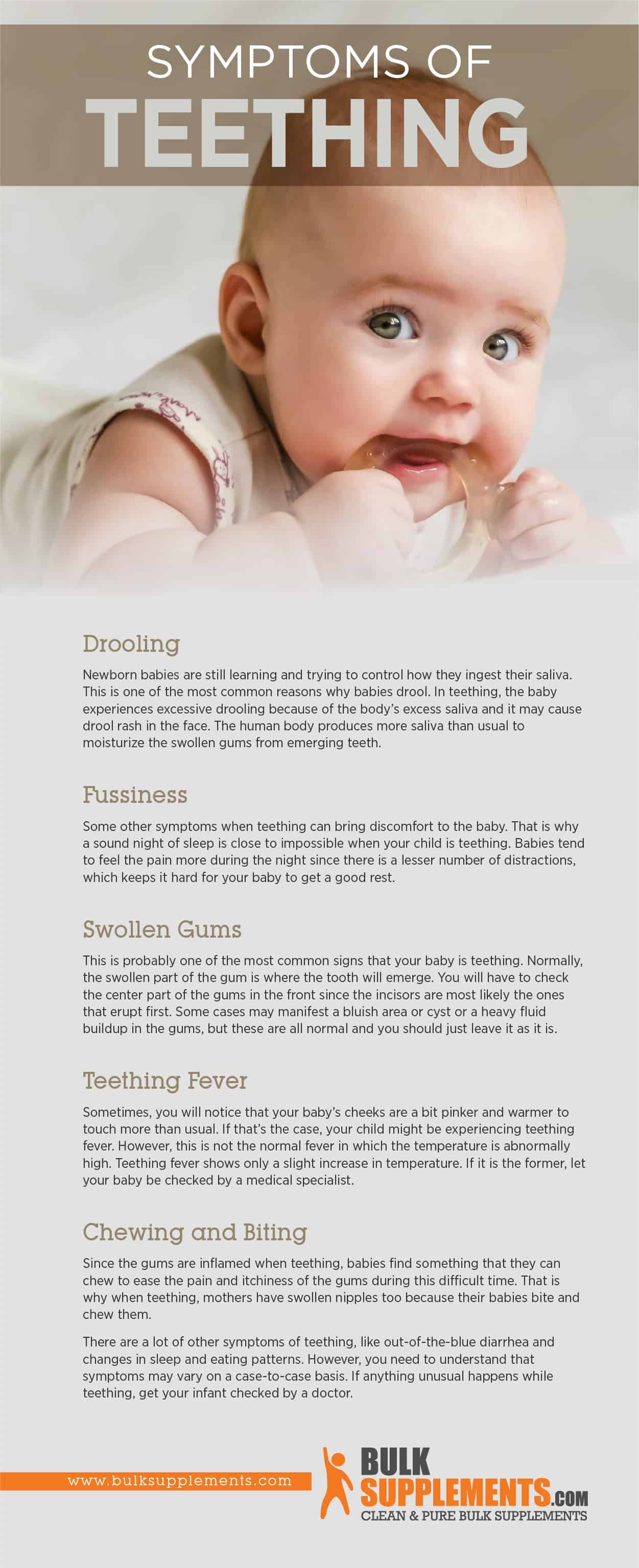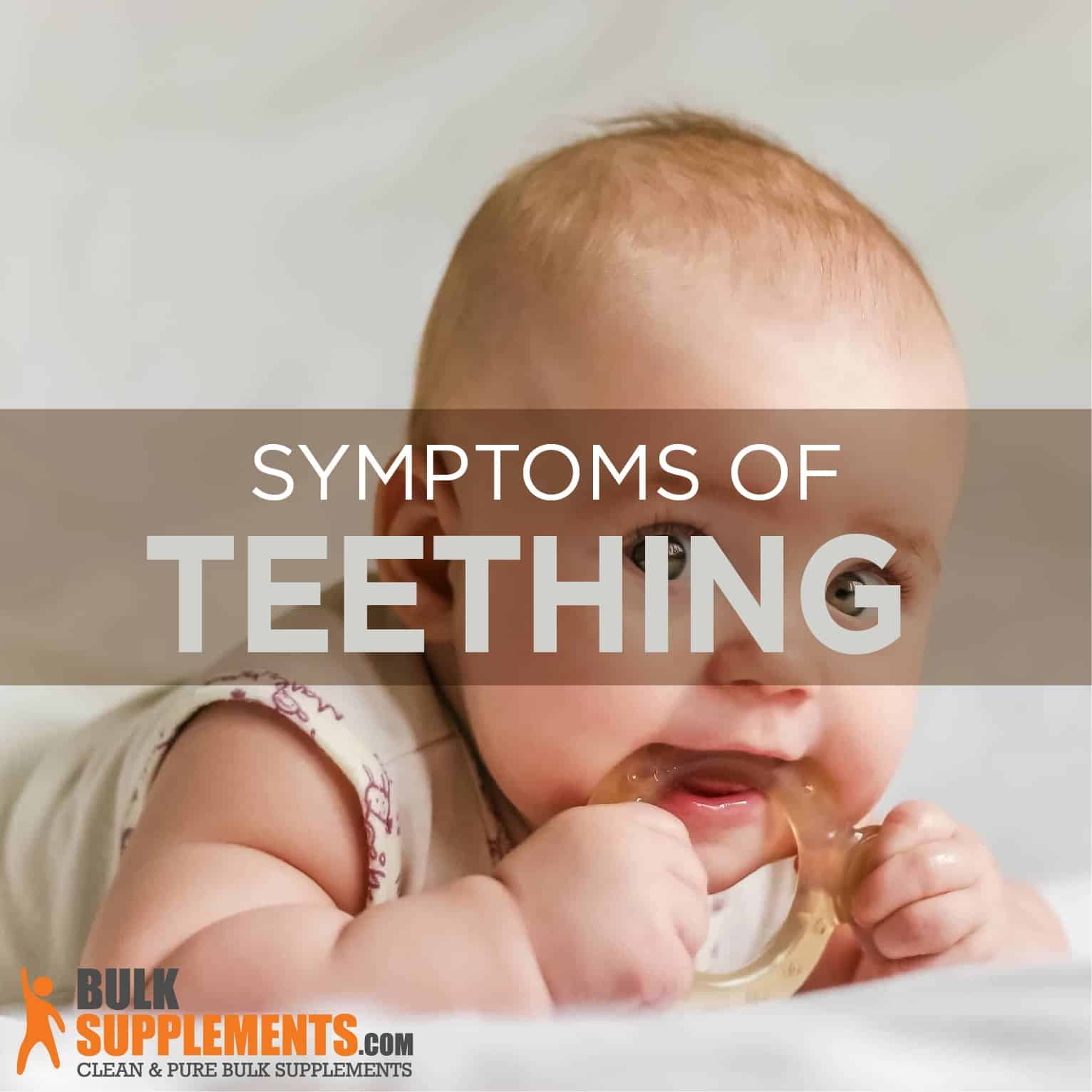What is Teething?
Teething is the process where baby teeth or “milk teeth” appear in sequence by popping out of the gums, which normally arrive in pairs. Most of the time, the first pair of teeth that erupts in the gums are the lower front teeth.
Teeth differ in shape, size and how they’re located in a person’s jaw. These variations help form and give shape to a person’s face.
After being born, people normally have 20 teeth that will start coming out of the gums around 6 months of age, and they normally fall out during childhood. During the six-month period after birth, there is typically a specific teething order for the different types of milk teeth. Then, all of the permanent teeth would have normally erupted by the time a person reaches the age of 21 (x).
The emerging of your baby’s first pair of teeth is a big event in his/her early life. However, it can be uncomfortable not only to your offspring, but also to you, as a parent. With that in mind, it is only right that you know a thing or two about teething. The more you become knowledgeable about it, the higher the chances of knowing what to do when your baby goes through it.
Types of Baby Teeth
Your child develops 20 baby teeth around the time they reach the age of 3. There are five types of milk teeth. They are:
Central and Lateral Incisors
When you smile (especially when you flash a wide grin), the teeth that others see right away are the central incisors. The central incisors are the ones in the front part of the mouth. The teeth on the side of the central incisors are called lateral incisors. There are eight incisors in total and they are the most noticeable when you open your mouth. This set of teeth does not only give light to a bright smile, but also serves several other purposes.
The central incisors are the teeth responsible for slicing the food we eat since they are thin and flat. Even if they are similar in shape, they still differ in size. The upper central incisors are the ones that are wide and are the most noticeable in the mouth. Those in the lower part are narrow and are smaller in size. The functions of the central incisors are the following (x):
- Support the shape and the look of the lips.
- Help in pronouncing the sounds of “t” and “th”.
- Guide the jaw to be in line with the right position every time the mouth closes.
The front central incisors normally emerge in 8-12 months and they fall out when the child ages 6-7 years old. The front lateral incisors erupt in 9-13 months after birth and fall out in the age of 7-8 years. On the other hand, the lower central incisors emerge from the gums within 6-10 months and shed in 6-7 years of age. The lower lateral incisors normally erupt in 10-16 months after birth and fall out within 6-7 years of age.
Canines
Canine teeth are the ones that are pointed and are positioned on the sides of the incisors at the front portion of the mouth. Canine teeth play different vital roles in speaking, eating and keeping the shape of our lips. Aside from that, they also serve as a guide for the teeth to be in position. When we eat food, these teeth aid in cutting and tearing the food into portions for easier chewing.
Most of the time, the upper canines appear within 16 to 22 months after your child’s birth and normally fall out when your child reaches 10 to 12 years old. On the other hand, the lower canines erupt at the first 17 to 23 months and fall out when the child is aged 9 to 11 years.
Molars
The molars are the teeth found at the back of the mouth. They are the large teeth that normally emerge in 13 to 19 months after your baby’s birth (x). Primarily, the molars are in charge of grinding the food we eat after chewing. Without them, the food we eat would be swallowed in bite-sized portions which isn’t good for digestion. Adults develop 12 molars which are grouped into three behind the canine teeth.
Teething Symptoms
You can easily tell when the teeth of your baby start growing. Most of the time, they are irritable, grumpy and bad-tempered in the daytime and they are sleepless from crying the whole night. Here are some of the other symptoms that emerge when your baby is teething.
Drooling
Newborn babies are still learning and trying to control how they ingest their saliva. This is one of the most common reasons why babies drool. In teething, the baby experiences excessive drooling because of the body’s excess saliva and it may cause drool rash in the face. The human body produces more saliva than usual to moisturize the swollen gums from emerging teeth (x).
Fussiness
Some other symptoms when teething can bring discomfort to the baby. That is why a sound night of sleep is close to impossible when your child is teething. Babies tend to feel the pain more during the night since there is a lesser number of distractions, which makes it hard for your baby to get a good nights rest (x).
Swollen Gums
This is probably one of the most common signs that your baby is teething. Normally, the swollen part of the gum is where the tooth will emerge. You will have to check the center part of the gums in the front since the incisors are most likely the ones that erupt first. Some cases may manifest a bluish area or cyst or a heavy fluid buildup in the gums, but these are all normal and you should just leave it as it is (x).
Teething Fever
Sometimes, you will notice that your baby’s cheeks are a bit pinker and warmer to touch more than usual. If that’s the case, your child might be experiencing teething fever. However, this is not the normal fever in which the temperature is abnormally high. Teething fever shows only a slight increase in temperature. If it is the former, let your baby be checked by a medical specialist (x).
Chewing and Biting
Since the gums are inflamed when teething, babies find something that they can chew to ease the pain and itchiness of the gums during this difficult time. That is why when teething, mothers have swollen nipples too because their babies bite and chew them (x).
There are a lot of other symptoms of teething, like out-of-the-blue diarrhea and changes in sleep and eating patterns. However, you need to understand that symptoms may vary on a case-to-case basis. If anything unusual happens while teething, get your infant checked by a doctor.

Teething Remedies
Just because teething symptoms are inevitable doesn’t mean they’re not treatable. Here are some ways to ease the pain of a teething toddler.
Cold Pressure
Although this may be one of the oldest treatments for teething, using and putting cold pressure in your baby’s swollen and in-pain gums actually does wonders. Try giving your child a safe object that may be put in the fridge and then chewed when it’s cold. The cold temperature numbs the pained area and the pressure helps in soothing the sore gums (x).
Teething Toys
Giving your infant a teething toy, one that is chewy, can be a great solution to relieve teething pain. There are several options on the kinds of teething toys that you can let them play with. There are teething rings, which are made with silicone or rubber that are safe. Wooden teethers are also available as some silicone teethers do not work well with babies. Choose a brand of wooden teether that utilizes food-grade dyes or water-based sealants.
Teething Necklaces
The most common form of teething necklaces are the amber ones. The trick is that when it’s near the baby’s body, the baltic amber reacts to the body heat by releasing a certain type of oil that has succinic acid. Succinic acid is a known anti-inflammatory property. Although many people doubt its effectiveness, a lot of mothers swear by them. When you put your baby to sleep, make sure that you remove the necklace or you put them on their wrist or ankle instead.
Rosehip
Of course, herbal remedies are on the list. Rosehip is also known as rose haw or rose hep, which comes from the fruit of — surprise! — rose plant. This plant is rich in vitamin C and antioxidants as well. Also, rosehip has anti-inflammatory properties according to a study in 2012 (x). Pay your doctor a visit to know the dosage appropriate for your child’s age.
Chamomile
Chamomile is probably one of the most common herbal remedies for teething. Many parents swear by it since it helps in relaxing and soothing the irritability of infants. They often mix it with their infant’s formula milk when their child doesn’t take it alone. Aside from that, chamomile is also an antimicrobial plant, so it helps in eliminating bad bacteria in your baby’s body (x).
And the list goes on. There are still a lot of remedies readily available for teething babies. But before you try one, make sure to get the approval of your baby’s pediatrician first to know more on what to do and what not to do when your infant is teething.
The Bottom Line
Although teething is one of the greatest milestones in a baby’s life, it can still be pretty worrisome since it will surely cause your baby some pain and discomfort. However, the more you learn about this subject, the better your child can be cared for without the hassle of going to a pediatrician and spending a huge amount of money.


